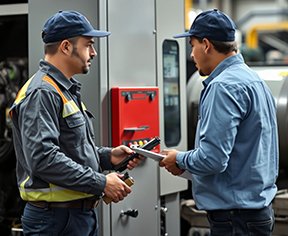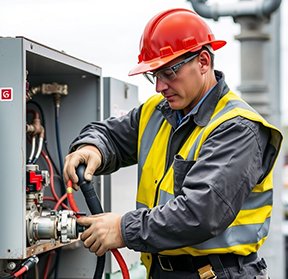Published: April 08, 2025 Updated: April 08, 2025
Building a Lean Maintenance Program for Productive Maintenance
 Companies strive for efficient operations. For a detailed discussion of efficiency and effectiveness, read this article. To achieve this, the discussion may include terms such as lean manufacturing and lean maintenance. In this article, we'll focus on the latter.
Companies strive for efficient operations. For a detailed discussion of efficiency and effectiveness, read this article. To achieve this, the discussion may include terms such as lean manufacturing and lean maintenance. In this article, we'll focus on the latter.
- The Role of Total Productive Maintenance (TPM) in Lean Management.
- The Benefits of Implementing a Lean Maintenance Program.
- Measuring the Effectiveness of Your Lean Maintenance Program.
- Overcoming Challenges in Lean Maintenance Implementation.
- Key Components of a Successful Lean Maintenance Program.
- How CMMS Integration Supports a Lean Maintenance Program.
The Role of Total Productive Maintenance (TPM) in Lean Management
LM finds its inspiration in TPM. This program provides a holistic approach to maximizing equipment effectiveness. You achieve this through the collaborative effort of all organizational levels. TPM emphasizes:
- Preventive maintenance (PM).
- Operator involvement in equipment care.
- Continuous improvement.
This philosophy lays the groundwork for the core principles of LM, including:
- Elimination of waste: This extends beyond just material waste. LM encompasses activities that don't contribute to equipment health or uptime.
- Other forms of waste include:
- Unplanned downtime. The next point helps minimize these incidents.
- Too much inventory. Overstocking usually means you have parts you don't use often. They end up taking up space better used for other items.
- Too little inventory. You might not think of this as waste, but if you need parts, say, for an emergency, you waste time waiting for emergency shipments. You waste money on those emergency purchases.
- Over maintenance. Too much PM wastes time and parts. It risks further issues with equipment. For example, over-lubrication.
- Waste of labor. Improper scheduling could mean the incorrect people handle repair jobs. Also, you risk not using technicians to their full capacity.
- Preventive maintenance: Prioritize regular inspections and planned maintenance tasks to prevent breakdowns and ensure optimal equipment performance.
- Continuous improvement: The lean approach fosters a culture of constant evaluation and refinement of maintenance practices.
Discover how streamlined maintenance processes can elevate production. Learn more.
The Benefits of Implementing a Lean Maintenance Program
Implementing an LM program offers a multitude of benefits for organizations across industries.
- Increased uptime: You focus on preventive maintenance and identifying potential issues before they escalate. This significantly reduces unplanned downtime, ensuring smooth operations.
- Reduced maintenance costs: Eliminating unnecessary repairs and optimizing parts inventory management leads to cost savings. Review some of these in the above points regarding waste.
- Improved equipment lifespan: Proper care and preventive maintenance extend the life of equipment. You don't have the extra costs of replacing assets before their time.
- Enhanced product quality: Reliable equipment translates to consistent production quality and minimizes product defects.
- Improved employee safety: A well-maintained work environment with properly functioning equipment reduces the risk of accidents and injuries.
- Improved morale: With lean maintenance, you work with production personnel to care for assets. This keeps employees from playing the "blame game." Production doesn't blame maintenance for problems. Technicians don't blame production for lack of communication.
Measuring the Effectiveness of Your Lean Maintenance Program
To ensure your lean maintenance program delivers the promised benefits, you need to regularly measure its effectiveness.
Metrics Used in Evaluation:
Mean Time Between Failures (MTBF): This metric measures the average time between equipment failures. This indicates the effectiveness of preventive maintenance.
Mean Time to Repair (MTTR): It reflects the average time taken to repair failed equipment. This highlights the efficiency of your maintenance procedures.
Overall Equipment Effectiveness (OEE): This metric captures the percentage of planned production time during which the equipment actually produces quality output. It considers availability, performance, and quality rate.
Maintenance Cost per Unit Produced: This metric helps track the cost-effectiveness of your maintenance program.
Aspects to Measure:
- Work order completion rate: This measures the efficiency of completing planned maintenance tasks. You might use a percentage of completed WOs in a specific date range.
- Inventory control: Tracks the effectiveness of managing spare parts inventory to avoid stockouts or overstocking. Review the dangers of each above.
- Preventive maintenance compliance: Ensures the completion of preventive maintenance tasks as scheduled.
- Employee training effectiveness: Evaluates the competence of maintenance personnel to perform their tasks effectively.
Overcoming Challenges in Lean Maintenance Implementation
To implement a program, you'll need to know what obstacles lay in your path. Determine them early and find solutions.
- Cultural shift: Transitioning from a reactive to a preventive maintenance mindset can require overcoming established workflows and employee resistance. A reactive strategy means you pay attention to assets only when they fail or break down. Many companies still operate this way. Discuss the benefits of PM.
- Initial investment: Implementing a CMMS or upgrading maintenance practices may require an initial investment. When shifting from RM to PM, you might incur extra purchases for inventory.
- Data collection and analysis: You need to understand what data you want. Read on for the benefits of a CMMS. Not having the right data poses problems. You won't know where to improve.
- Sustaining the program: Maintaining a culture of continuous improvement and employee engagement requires ongoing commitment from leadership.
 Key Components of a Successful Lean Maintenance Program
Key Components of a Successful Lean Maintenance Program
A successful lean maintenance program incorporates several key aspects:
- Preventive maintenance plan: Develop a comprehensive plan for scheduled inspections, lubrication, and other preventive maintenance tasks.
- Standardized work procedures: Create clear and consistent procedures. Standard work order descriptions. Standard safety protocols.
- Root cause analysis: Don't just fix breakdowns; identify and address the root causes of equipment failures to prevent future occurrences.
- Performance tracking: Regularly monitor key metrics like MTTR and MTBF to identify areas for improvement. Always look for and discuss ways to improve.
- Communication and collaboration: Foster open communication between maintenance personnel, operators, and management.
How CMMS Integration Supports a Lean Maintenance Program
Think about all of the topics we've discussed. From all of the metrics to PMs to work orders. Now, look at a CMMS. It acts as a central database for all of these and more.
- Work order management: A CMMS streamlines the creation, assignment, and tracking of work orders for preventive and corrective maintenance tasks.
- Inventory control: The system helps manage spare parts inventory by tracking stock levels, identifying reorder points, and preventing stockouts.
- Scheduling: CMMS automates the scheduling of preventive maintenance tasks and other repairs.
- Data collection and analysis: The system facilitates data collection on equipment performance, maintenance activities, and costs, enabling informed decision-making. Does the CMMS offer equipment readings recording and depreciation tracking?
- Reporting and analytics: CMMS generates reports that provide valuable insights into program effectiveness and identify areas for improvement. Look for a system that offers plenty of reports and plenty of parameters to hone the information.
Make Lean Management Work for Your Maintenance Team
As W. Edwards Deming, a pioneer in quality management, said, "It is not necessary to change. Survival is not mandatory."
In today's competitive landscape, look to lean maintenance to not just survive, but thrive. Use the following skills:
- Communications. Be open to discussion, comments, and other feedback.
- Time Management. This works alongside organizational skills. Use your time wisely in all that you do.
- Flexibility. Adopt successful concepts and adapt them to your needs.
Don't try to tackle all of them at once. Work on one, enhance your skills, and always look to improve.
Mapcon / 800-922-4336
MAPCON CMMS software empowers you to plan and execute PM tasks flawlessly, thanks to its wealth of features and customizable options. Want to see it for yourself? Click the button below to get your FREE 30-day trial of MAPCON!
Try It FREE!